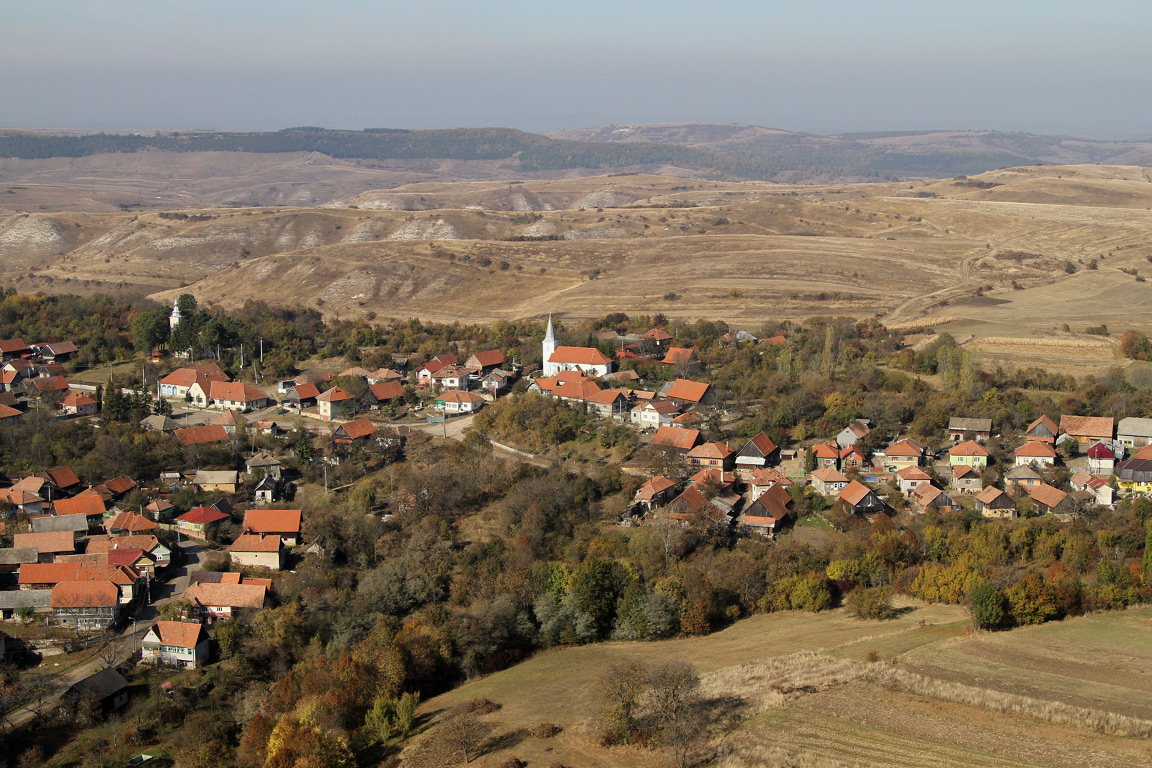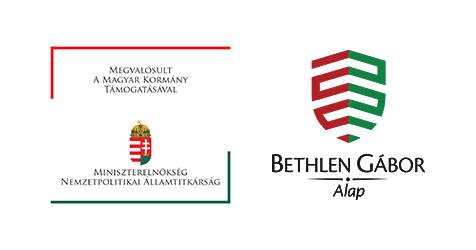Dumbrava (Gyerővásárhely)
Traveling from Bánffyhunyad (Huedin) to Kolozsvár (Cluj), make a left off the main road after the descent from the Gyerőfalva (Păniceni/Pányik) plateau. Gyerővásárhely (Dumbrava), with its red ceramic rooftops and small but radiant white tower visible from afar, lies in the foggy valley 600 meters to the north. This panoramic, well-situated village lies at the altituge of 650-700 meters in the embrace of the Gyerőfi escarpment.
As the name “Gyerő” suggests, the village is the ancestral estate of the Gyerőfi family. “Vásárhely,” which means marketplace, indicates that traders from around Kapus (Căpuș) established a market there to avoid paying tolls on the pass. The old market site is still visible in the village center.
The settlement dates back to the Árpád era. It is mentioned in a medieval Latin charter dated in 1288, from the reign of László IV (Kun), that refers to it as “terra Vassarhel.”
By 1296 it is referred to as “Villa Vassarhel” (the village of Vásárhely). East of the church stood the ancenstral mansion of the Gyerőfi family. The family owned woods, lakes, and vineyards near the village, as well as estates in Gyerőfalva (Pányik/Păniceni), Inaktelke (Inucu), Magyarkiskapus (Căpușu Mic), Bánffydongó (Dângău Mare), and Magyargyerőmonostor (Mănăstireni).
Miklós Gyerőfi (of Kalota) acquired the estate as a gift from his friend King Andrew III whom he helped free from captivity in Vienna. Gáspár Gyerőfi, János Gyerőfi, György Gyerőfi and their wives were patrons of the village and its church.
In 1330 the village’s church was an independent chapter of the Gyalu (Gilău) parish. In 1606 Ferenc Gyerőfi and Ferenc Mikola attended the Medgyes Synod, where freedom to practice the “new faith” was declared. The Gyerőfi, Mikola, Radnót, and Kabos families and their serfs converted to the Protestant faith. The Gyerőfis settled Moți Romanian servants in the village, and we can still see their houses opposite those of the native population.
From the highway, the Gyerőfi escarpment is visible toward the southeast. According to folk legend, Gyöngyös Gyerőfi leaped into the depths while on horseback in pursuit of a stag. It is worth stopping for a minute to observe the parish house, designed by Károly Kós and still in good condition.
Traditional folk dress is still common in the Reformed community; girls dress up on holidays. After 1990 the church regained its confiscated lands and woods. The current population includes 190 Reformed ethnic Hungarians, 60 Orthodox ethnic Romanians, and 150 Roma.
The Reformed church
In 1831 the church we know today was built on the site of the old church. The following inscription can be seen on the ceiling: “This ceiling endowed by the ecla. Gyerővásárhely was constructed by Lőrincz Asztalos of Kolozsvár in 1757.” There is another inscription according to which the ceiling, along with part of the church, was built in 1771 during pastor András Görgényi’s term. This is the year the church was expanded.
The church’s interior
1. The ceiling with its 81 painted tiles is the 1757 work of Lőrincz Asztalos “Carpenter” of Kolozsvár (also known as Lőrincz Umling; the Umling carpenter family played a significant role designing the decorative interiors of churches in the Kalotaszeg and Mezőség regions). The ornamentation contains biblical elements, mythological figures, and ancient Magyar floral designs.
2. The beautiful painted canopy was completed in 1770. The pinnacle depicts a pelican feeding its young. Both Umling brothers worked on the canopy: Lőrincz decorated the sounding board, and József the crown.
3. In the wall next to the pulpit we find the 1578 headstone of Mikola Erzsébet, wife of Gáspár Gyerőfi. Adorned with the Gyerőfi coat of arms, the Latin-inscribed headstone honors the memory of the noblewoman.
4. The Baroque organ is a beautiful ornament of the church. The parish purchased it in the early 20th century from the Saxon evangelical church in Kolozsvár. A popular choice for recitals and uniquely ornate, it is considered one of the top organs in the country.
5. The south wall bears the following Latin inscription: “If God is with us, whoever is against us.”
Contributions by Katalin Maksay, Zsolt Szabó and Enikő Venczel
Bibliography: Dezső Malonyay: A magyar nép művészete (Hungarian Folk Art); Margit Kiss: Kispetri, református templom (Reformed Church of Kispetri); Árpád Furu: Kalotaszeg népi építészete (Folk Architecture of Kalotaszeg); Béla Kabay: Kalotaszegi műemlékek kis adattára (Small Archive of the Monuments of Kalotaszeg); Ferenc Mihály: Elpusztult templomi festett famennyezetekről (About Perished Painted Church Ceilings); Kalotaszeg antológia 1-2 (Anthology of Kalotaszeg 1-2). 1990–2008. Editor, Pál Buzás; Kalotaszegi krónikácskák (Small Chronicles of Kalotaszeg). Compiled by János Kovács Kuruc and Erzsébet Ildikó Szalai.
Photos by: Hunor Magyari, Ábel Juhász, Tünde Szántó, Róbert Branea.








